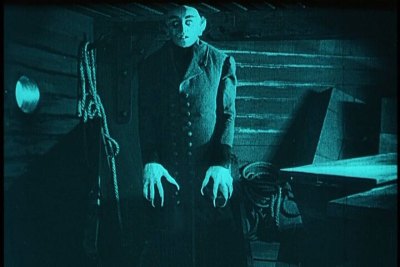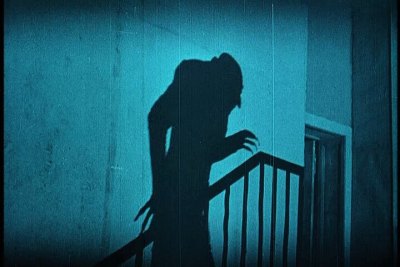| Reviews & Columns |
|
Reviews DVD TV on DVD Blu-ray 4K UHD International DVDs In Theaters Reviews by Studio Video Games Features Collector Series DVDs Easter Egg Database Interviews DVD Talk Radio Feature Articles Columns Anime Talk DVD Savant Horror DVDs The M.O.D. Squad Art House HD Talk Silent DVD
|
DVD Talk Forum |
|
|
| Resources |
|
DVD Price Search Customer Service #'s RCE Info Links |
|
Columns
|
|
|
Nosferatu (Kino)
 This DVD is part of the F. W. Murnau Collection boxed set. Read the reivew of the entire collection here.
This DVD is part of the F. W. Murnau Collection boxed set. Read the reivew of the entire collection here.In 1922 F. W. Murnau burst onto the international film scene with his horror masterpiece, Nosferatu. Though Murnau's films had been noticed before this one, none of them had achieved the critical success as this study in terror.
Most people familiar with silent films have heard the origins of this film. When the creators did not want to go to the expense of purchasing the right to Bram Stoker's Dracula, they changed the names and made it anyway. They did pare the novel down to its core essentials, but at its heart, it is still Stoker's Dracula.
Real estate agent Thomas Hutter (Gustav von Wangenheim,) is sent to the Carpathian Mountains to finalize the sale of an estate to Count Graf Orlok (Max Schreck.) Laughing off the locals warnings, Hutter travels to Orlok's castle, but soon stops laughing when he sees the eerie looking Count. After completing the sale, Orlok sees an image of Hutter's wife, Ellen (Greta Schröder) and departs for her town of Bremen by boat. When the boat arrives, all the crew are dead, and rats flee the ship. Orlok wants to feed on Ellen, but her husband realizes the danger she is in and is hurrying back to protect her.
This film is a masterpiece of horror and of German Expressionism filmmaking. The more often you see this film, the more amazing it gets. The low camera angles, sharp contrasts, and dreamlike atmosphere all come together to form a distortion of the real world. This distortion makes the movie oddly unsettling, and the introduction of Count Orlok greatly adds to the eeriness.
 The acting was superb all around, but Max Schreck was simply amazing. His portrayal of Graf Orlok was both horrifying and intriguing. You couldn't look away from his odd appearance. This vampire was no suave, elegant gentleman like Bela Lugosi portrayed him. Schreck's character was a ghastly dead creature, more rat than man. The talon like finger, large deep set eyes and unnaturally long ears made him look inhuman. His acting accentuated the evil in his character that matched the decaying exterior. No one would ever play the lord of vampires so effectively again.
The acting was superb all around, but Max Schreck was simply amazing. His portrayal of Graf Orlok was both horrifying and intriguing. You couldn't look away from his odd appearance. This vampire was no suave, elegant gentleman like Bela Lugosi portrayed him. Schreck's character was a ghastly dead creature, more rat than man. The talon like finger, large deep set eyes and unnaturally long ears made him look inhuman. His acting accentuated the evil in his character that matched the decaying exterior. No one would ever play the lord of vampires so effectively again.
What this all boils down to is that this is a fantastic movie. It works on many levels, it is artistic, innovative and even beautiful. There are images in this movie that will stay with you long after the film is finished. Of all the adaptations of Dracula that would come after this, Nosferatu is still the best.
After the movie was released, Stoker's wife sued, and eventually won a court settlement that included the burning of all copies of the film. Luckily, there were prints that escaped the flame in other countries. It is ironic that Florence Stoker wanted the film destroyed, since many film historians note Nosferatu's popularity as a reason the stage play, and the later movie versions, were ever created. Thereby giving eternal life to her husband's greatest work.
The DVD:
Audio:
There are two audio tracks available on this disc, both presented in stereo. The default track contains music written by Donald Sosin with vocals by Joanna Seaton. The alternative track has music composed by Gerard Hourbette and Thierry Zaboitzeff, preformed by Art Zoid.
The problem with both these sound tracks is that they are absolutely horrible. I am amazed that Kino didn't come up with a better track to enjoy this movie by. The default track prominently features a pan flute, or similar instrument, in many of the movements. This music sounds cheap and inappropriate. To make matters worse, this track also includes the sounds of a woman gasping and moaning during some scenes. (Such as when Ellen dreams that her husband is in trouble.) These vocal sound like a bad dub job on a porno movie.
The other track is even worse, if you can believe that. The music, and I use the word loosely here, has a very heavy industrial sound mixed with new age minimalist sounds. there will be the sound of wind blowing through chimes, followed by loud metallic percussion like machines stamping out metal parts. It really wasn't musical at all.
I was deeply disappointed in both musical scores.
Video:
The video quality was very good for this film. I don't think I've ever seen it look better. That is not to say it is pristine, even when its age is taken into consideration. The negatives and many first print copies were destroyed due to Mrs. Stoker's legal suit. The only copies left in existence are somewhat removed from the camera negative. This version of the film is a transfer of the 1995 Bologna restoration. It has a lot of dust and specks and other print damage. There is some emulsion decomposition in a few scenes, and there are missing frames too. The contrast is not excellent, but it is very good, though the picture is darker than it should be. There is a good amount of detail present, and the picture if fairly sharp. It is easy to pick out folds in cloth and other details that are often missing. A nice copy, but not the definitive restoration I was hoping for. (That has not been done yet, probably due to the amount of time and money it would take to digitally remove all the scratches and imperfections.)
The Extras:
There are excerpts from several other Murnau films: Journey into Night, Haunted Castle, Phantom, The Last Laugh, Faust, and Tabu.
Kino provides a scene comparison of the dinner scene. They include an excerpt from the novel, the shooting script for Nosferatu, the filmed scene, and an audio excerpt from the Mercury Theater on the Air Radio show. The audio on the radio show was muddled and hard to understand.
Lastly, there is a photo gallery of production stills and magazine covers that featured the movie.
Final Thoughts:
Books have been written about this film and the German Expressionist movement. I could go on about the use of location shooting, frame composition, and the innovative use of montage, but that is not in the purview of this review. Suffice to say that this is an excellent film. The video quality, while not perfect, is very good with nice contrast and sharpness. Unfortunately the sound tracks both left a lot to be desired. This DVD is still highly Recommended, if you watch it with the sound muted.
|
| Popular Reviews |
| Sponsored Links |
|
|
| Sponsored Links |
|
|
| Release List | Reviews | Shop | Newsletter | Forum | DVD Giveaways | Blu-Ray | Advertise |
|
Copyright 2024 DVDTalk.com All Rights Reserved. Legal Info, Privacy Policy, Terms of Use,
Manage Preferences,
Your Privacy Choices | |||||||















